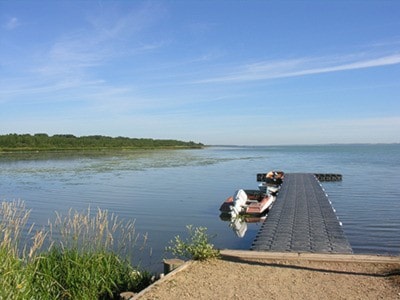Efforts to improve the quality of water in one of two area lakes has taken a leap forward while work on another has stalled somewhat.
Craig McLeod, Ray Prins and Doug Bradley - representatives of the Gull Lake Watershed Society - made a presentation to Ponoka County council at its Tuesday, Feb. 9 meeting in order to provide them with information on what steps are being taken to better manage the quality of the lake’s water to the benefit of all users.
Called the Gull Lake Wetlands Project, the society has teamed up with a number of stakeholders in the area in hopes that improved stewardship of the sensitive ecological region will sustain the lake for years to come and not fall into a similar cycle that has befallen nearby Pigeon Lake.
“This (project) is a win-win scenario. We have a good relationship developed with the local agriculture community and a willingness to work together,” McLeod stated.
“Wetlands and settling ponds are more than something that is simply annoying, it’s amazing what cattails and reeds can do to improving the quality and cleaning water.”
The overall project will see the society, the Summer Village of Parkland Beach, some area farmers as well as potentially Ducks Unlimited working to create some settling ponds and enhanced wetland habitat. Some of the work will be done on municipal reserve land set aside with the Twin Creeks subdivision with other work set for the east side of the lake near Raymond Shores and further work to divert runoff in the summer village to a more natural area where it can be filtered somewhat before entering the lake.
“From the fields that are plowed, there is a strong runoff into the lake. The highest flows are from the creek at the north end. The work being planned will help prevent the blue-green algae formations by allowing the two main nutrient loading factors that cause it - phosphorus and nitrogen - to settle out,” McLeod explained.
“The wetlands and settling ponds will also replenish and restore groundwater in addition to other benefits.”
McLeod stated the group’s wake up call came two years ago when the lake was hit with its first blue-green algae warning by Alberta Health.
“We wanted to be proactive in turning this ship around,” he said.
That’s when they began to look at what options there were, since many of the problems causing the issue of poor water quality stemmed from development plans from the 1970s.
“The agricultural development done back then - by taking out natural wetlands to expand culivated land - created a lot of the problems that we need to fix by restoring the constructive wetlands to store water and let those nutrients settle,” Prins said.
McLeod added that they approached Ducks Unlimited as a way of being able to tap into some available money for the estimated $61,000 project. Although, the group may down the road ask the county for either financial or in-kind assistance.
“That cost is with all of the excavating and finishing work, which could be cut down if some of the work doesn’t have to be contracted out,” he said.
“If all of the sites in our inventory were completed and implemented within Lacombe and Ponoka counties over the next five to seven years, the lake would be healthier than it has been in years. There has been good buy-in (from all stakeholders) and the projects I mentioned could be kickstarted very quickly.”
The one suggestion the group had for Ponoka County was that they continue to implement the best practices of road construction and subdivision development in their projects in order to better assist with natural wetlands and drainage patterns so as not to negatively affect the lake.
Reeve Paul McLauchlin did have one additional suggestion for the group to consider and that would be to engage Ducks Unlimited to perform a wetlands assessment as it might be helpful in future planning and potentially provide ideas to further improve water flows and quality.
Meanwhile, Joanne McMillan from the stakeholders group at Chain Lakes explained they are continuing efforts to address water quality issues, but are struggling with membership and they are curious as to when a hydrogeological assessment of the lakes will be done.
County chief administrative officer Charlie Cutforth noted that there are presently five water quality monitoring stations around Gull Lake and that something similar could be done at Chain Lakes.
“We are quite a bit behind where the Gull Lake group is and our group is diminishing,” McMillan said.
“It’s been helpful to have Craig (McLeod) as a contact and we’ve been in touch with the technical people at Alberta Environment that have been assigned to look at the data. We are in the beginning stages and then we can begin to look where the contamination is coming from. Ultimately it comes down to land stewardship and I anticipate it being a rough go with nearly 100 per cent of the area running intensive livestock operations.
“In order to try to give value to water, we all need to work together so that both can thrive.”
